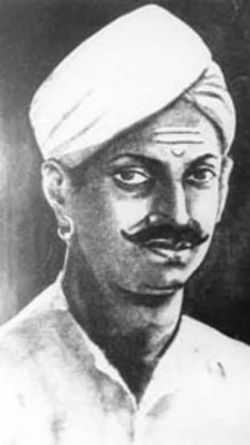Mangal Pandey
| Mangal Pandey | |
|---|---|

| |
| India Post stamp of Mangal Pandey (1984) | |
| Born | 19 July 1827 |
| Birthplace | Nagwa, Ballia district, Ceded and Conquered Provinces, British India (now Uttar Pradesh, India) |
| Died | 08 April 1857 (aged 29) |
| Place of death | Barrackpore, Bengal Presidency, British India (now West Bengal, India) |
| Resting place | Barrackpore, near Kolkata |
| Nationality | Indian |
| Occupation | Sepoy (Soldier) in British East India Company |
| Years active | 1849–1857 |
| Known for | Sparking the Indian Rebellion of 1857 |
| Notable works | Act of Revolt against British Rule (1857) |
| Awards | Honored posthumously as a national hero |
| Spouse(s) | Unknown |
| Children | None |
| Parents | Divakar Pandey (father) |
| Religion | Hinduism |
| Website | |
Mangal Pandey (19 July 1827 – 8 April 1857) was an Indian soldier in the British East India Company who played a pivotal role in triggering the Indian Rebellion of 1857, regarded as India's first struggle for independence.
Early Life
Mangal Pandey was born in the village of Nagwa in Ballia district of present-day Uttar Pradesh into a Hindu Brahmin family. Despite his modest background, he joined the 34th Bengal Native Infantry regiment in 1849.
The 1857 Revolt
In 1857, Pandey refused to use the newly introduced Enfield rifle cartridges rumored to be greased with cow and pig fat. On 29 March 1857, he attacked British officers at the Barrackpore cantonment, encouraging others to join the revolt.
He was captured, court-martialed, and sentenced to death. To prevent a wider rebellion, the British hanged him on 8 April 1857, ten days before the scheduled execution date.
Legacy
- Seen as one of India’s first martyrs for freedom.
- Honored with a commemorative stamp in 1984 by India Post.
- The film Mangal Pandey: The Rising (2005), starring Aamir Khan, depicted his life.
- Memorials, institutions, and public buildings are named after him across India.
Honors
- Recognized as a national hero.
- Featured in Indian school curriculum as an early symbol of patriotic resistance.
See Also
- Indian Rebellion of 1857
- Rani Lakshmibai
- Bahadur Shah Zafar
- Tatya Tope
